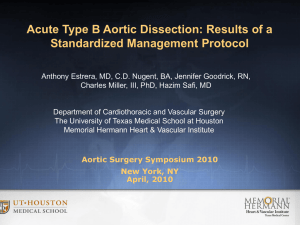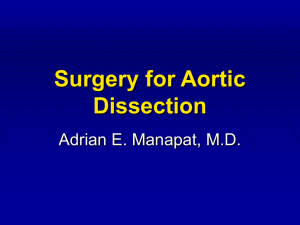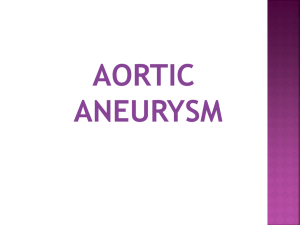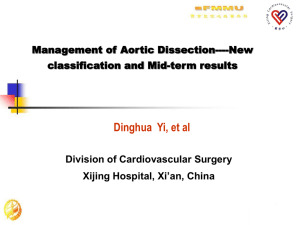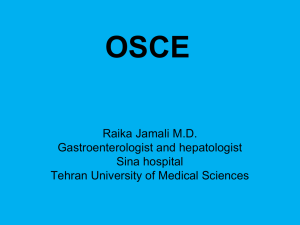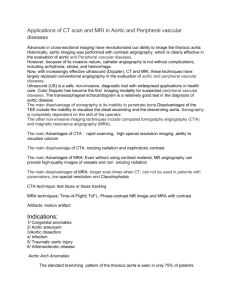THE KURSK STATE MEDICAL UNIVERSITY
advertisement
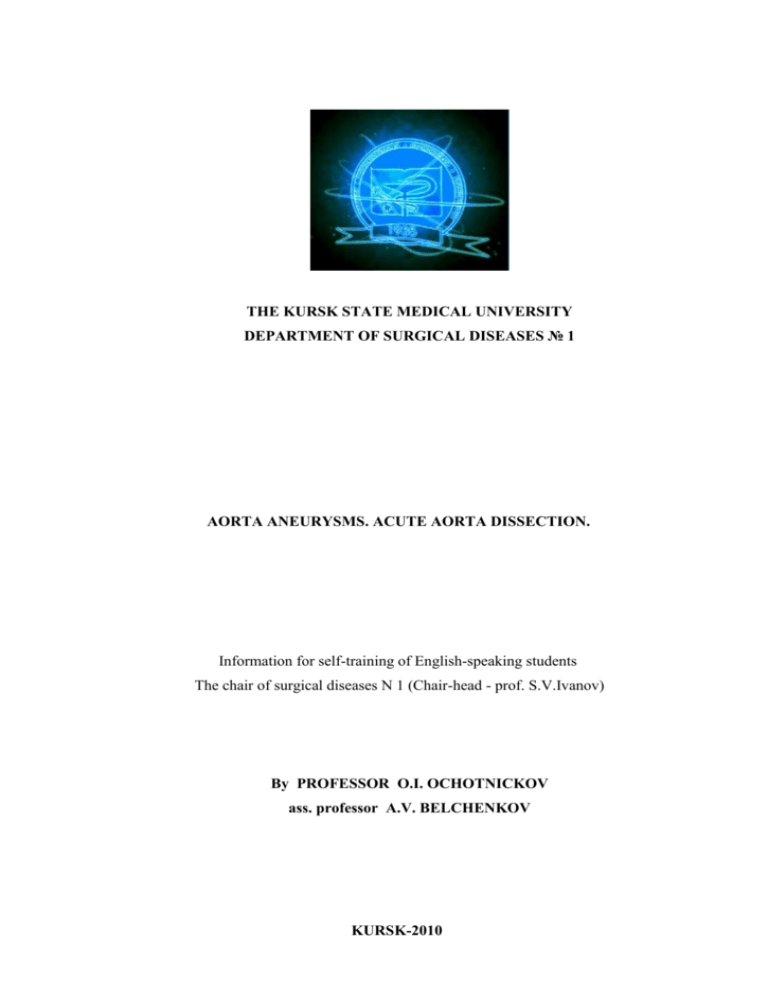
THE KURSK STATE MEDICAL UNIVERSITY DEPARTMENT OF SURGICAL DISEASES № 1 AORTA ANEURYSMS. ACUTE AORTA DISSECTION. Information for self-training of English-speaking students The chair of surgical diseases N 1 (Chair-head - prof. S.V.Ivanov) By PROFESSOR O.I. OCHOTNICKOV ass. professor A.V. BELCHENKOV KURSK-2010 2 AORTA ANEURYSMS I. INTRODUCTION An aortic aneurysm is a general term for any swelling (dilatation or aneurysm) of the aorta, usually representing an underlying weakness in the wall of the aorta at that location. While the stretched vessel may occasionally cause discomfort, a greater concern is the risk of rupture, which causes severe pain; massive internal hemorrhage; and, without prompt treatment, results in a quick death.Abdominal aortic aneurysm, also written as AAA and often pronounced 'triple-A', is a localized dilatation of the abdominal aorta, that exceeds the normal diameter by more than 50%. The normal diameter of the infrarenal aorta is 2 cm. It is caused by a degenerative process of the aortic wall, but the exact etiology remains unknown. It is most commonly located below the kidneys (infrarenally; 90%), other possible locations are above or at the level of the kidneys (suprarenal and pararenal). The aneurysm can extend to include one or both of the iliac arteries. An aortic aneurysm may also occur in the thorax. An abdominal aortic aneurysm occurs most commonly in older individuals (between 65 and 75), and more in men and smokers. There is moderate evidence to support screening in individuals with these risk factors. The majority of abdominal aortic aneurysms do not cause symptoms. Symptomatic and large aneurysms (>5.5 cm in diameter) are considered for repair. The most important complication of an abdominal aortic aneurysm is rupture, which is most often a fatal event. An abdominal aortic aneurysm weakens the walls of the blood vessel, leaving it vulnerable to bursting open, or rupturing, and spilling large amounts of blood into the abdominal cavity, leading to only minutes of life remaining. II. GENERAL AIM OF THE SESSION General aim of the session includes acquisition the following by students: 3 1. Knowledges on clinical signs, diagnose, medicine treatment and surgical management of aortic aneurysms. 2. Practical skills of disease anamnesis accumulation and objective examination of the patients. 3. Opportunity to create plan of laboratory and instrumental investigation, ability to create and to prove clinical diagnosis, to make indications and contra-indication for surgical treatment and to choose the mode of it or conservative therapy in patient with aortic aneurysms. III. TRAINING-AIM TASKS FOR SELF-TRAINING After individual studying of the material every student have to: A/ to know: • Classification of this diseases • Pathogenesis of more spread forms of the diseases • Clinical picture of this diseases • Diagnostic value of different instrumental methods. • Indications and contra-indication for surgical treatment •Complex conservative treatment •Principles of surgical treatment and technics of operation. B/ be able • To find main complains, symptoms and signs of the deep veins thrombosis, accumulate anamnesis in cases and staging this disease. • To realize objective examination of patients with this diseases. • Be able to assess received datas of US-scanning, X-Ray examination, angiography, CT-examination, laboratory datas • To create indications and contra-indication for surgical treatment. III. INITIAL LEVEL OF KNOWLEDGES 4 Anatomo-physiological datas about the aorta have been studied on 3-4-th courses. Different modes of surgical procedures have been studied on course of operative surgery. You should restore this study material. IV. MATERIAL, IS OBL1GATIVE FOR TOPIC MASTERING History The first historical records about AAA are from Ancient Rome in the 2nd century AD, when Greek surgeon Antyllus tried to treat the AAA with proximal and distal ligature, central incision and removal of thrombotic material from the aneurysm. However, attempts to treat the AAA surgically were unsuccessful until 1923. In that year, Rudolph Matas (who also proposed the concept of endoaneurysmorrhaphy), performed the first successful aortic ligation on a human. Other methods that were successful in treating the AAA included wrapping the aorta with polyethene cellophane, which induced fibrosis and restricted the growth of the aneurysm. Albert Einstein was operated on by Rudolf Nissen with use of this technique in 1949, and survived five years after the operation. Epidemiology AAA is uncommon in individuals of African, Asian, and Hispanic heritage. The frequency varies strongly between males and females. The peak incidence is among males around 70 years of age, the prevalence among males over 60 years totals 2-6%. The frequency is much higher in smokers than in non-smokers (8:1), and the risk decreases slowly after smoking cessation. Other risk factors include hypertension and male sex. In the U.S., the incidence of AAA is 2-4% in the adult population. AAA is 4-6 times more common in male siblings of known patients, with a risk of 20-30%. Rupture of the AAA occurs in 1-3% of men aged 65 or more, the mortality is 70-95%. Etiology The exact causes of the degenerative process remain unclear. There are, however, some theories and risk factors defined. Genetic influences: The influence of genetic factors is highly probable. The high 5 familial prevalence rate is most notable in male individuals. There are many theories about the exact genetic disorder that could cause higher incidence of AAA among male members of the affected families. Some presumed that the influence of alpha 1-antitrypsin deficiency could be crucial, some experimental works favored the theory of X-linked mutation, which would explain the lower incidence in heterozygous females. Other theories of genetic etiology were also formulated. Hemodynamic influences: Abdominal aortic aneurysm is a focal degenerative process with predilection for the infrarenal aorta. The histological structure and mechanical characteristics of infrarenal aorta differ from those of the thoracic aorta. The diameter decreases from the root to the bifurcation, and the wall of the abdominal aorta also contains a lesser proportion of elastin. The mechanical tension in abdominal aortic wall is therefore higher than in the thoracic aortic wall. The elasticity and distensibility also decline with age, which can result in gradual dilatation of the segment. Higher intraluminal pressure in patients with arterial hypertension markedly contributes to the progression of the pathological process. Atherosclerosis: The AAA was long considered to be caused by atherosclerosis, because the walls of the AAA are frequently affected heavily. However, this theory cannot be used to explain the initial defect and the development of occlusion, which is observed in the process. Other causes: Other causes of the development of AAA include: infection, trauma, arteritis, cystic medial necrosis (m. Erdheim) and connective tissue disorders (e.g. Marfan syndrome, Ehlers-Danlos syndrome). Pathophysiology The most striking histopathological changes of aneurysmatic aorta are seen in tunica media and intima. These include accumulation of lipids in foam cells, extracellular free cholesterol crystals, calcifications, thrombosis, and ulcerations and ruptures of the layers. There is an adventitial inflammatory infiltrate. However, the degradation of tunica media by means of proteolytic process seems 6 to be the basic pathophysiologic mechanism of the AAA development. Some researchers report increased expression and activity of matrix metalloproteinases in individuals with AAA. This leads to elimination of elastin from the media, rendering the aortic wall more susceptible to the influence of the blood pressure. Classification Aortic aneurysms are classified by where on the aorta they occur; aneurysms can appear anywhere. An aortic root aneurysm, or aneurysm of sinus of Valsalva, appears on the sinuses of Valsalva or aortic root. Thoracic aortic aneurysms are found on the thoracic aorta; these are further classified as ascending, aortic arch, or descending aneurysms depending on the location on the thoracic aorta involved. Abdominal aortic aneurysms, the most common form of aortic aneurysm, are found on the abdominal aorta, and thoracoabdominal aortic aneuryms involve both the thoracic and abdominal aorta. There are other classifications that might help treatment. Manifestations and Diagnosis AAAs are commonly divided according to their size and symptomatology. An aneurysm is usually considered to be present if the measured outer aortic diameter is over 3 cm (normal diameter of aorta is around 2 cm). The natural history is of increasing diameter over time, followed eventually by the development of symptoms (usually rupture). If the outer diameter exceeds 5.5 cm, the aneurysm is considered to be large. For aneurysms under 5.5 cm, the risk of rupture is low, so that the risks of surgery usually outweigh the risk of rupture. Aneurysms less than 5.5 cm are therefore usually kept under surveillance until such time as they become large enough to warrant repair, or develop symptoms. The vast majority of aneurysms are asymptomatic. The risk of rupture is high in a symptomatic aneurysm, which is therefore considered an indication for surgery. Possible symptoms include low back pain, flank pain, abdominal pain, groin pain or pulsating abdominal mass. The complications include rupture, peripheral embolisation, acute aortic occlusion, and aortocaval (beteween the aorta and inferior vena cava) or aortoduodenal (between the aorta and the duodenum) 7 fistulae. On physical examination, a palpable abdominal mass can be noted. Bruits can be present in case of renal or visceral arterial stenosis. CT image showing an abdominal aortic aneurysm. As most of the AAAs are asymptomatic, their presence is usually revealed during an abdominal examination for another reason - the most common being abdominal ultrasonography. A physician may also detect the presence of an AAA by abdominal palpation. Ultrasonography provides the initial assessment of the size and extent of the aneurysm, and is the usual modality for surveillance. Preoperative examinations include CT, MRI and special modes thereof, like CT/MR angiography. Angiography may be useful also, as an additional method of measurement for the planning of endoluminal repair. Note that an aneurysmal aorta may appear normal on angiogram, due to thrombus within the sac. Rupture The clinical manifestation of ruptured AAA can include low back, flank, abdominal or groin pain, but the bleeding usually leads to a hypovolemic shock with hypotension, tachycardia, cyanosis, and altered mental status. The mortality of AAA rupture is up to 90%. 65–75% of patients die before they arrive at hospital and up to 90% die before they reach the operating room. The bleeding can be retroperitoneal or intraperitoneal, or the rupture can create an aortocaval or aortointestinal (between the aorta and intestine) fistula.. Flank ecchymosis (appearance of a bruise) is a sign of retroperitoneal hemorrhage, and is also called the Grey-Turner sign. Ruptured AAA is a clinical diagnosis: the presence of the triad of abdominal pain, shock and pulsatile abdominal mass makes the diagnosis; no further investigations are required for diagnostic purposes, and imaging should not delay surgery. The operative mortality has slowly decreased over several decades but remains higher than 40%. Treatment 8 The treatment options for asymptomatic AAA are immediate repair, surveillance with a view to eventual repair, and conservative management. There are currently two modes of repair available for an AAA: open aneurysm repair (OR), and endovascular aneurysm repair (EVAR). Conservative treatment is indicated in patients where repair carries a high risk of mortality and also in patients where repair is unlikely to improve life expectancy. The two mainstays of the conservative treatment are smoking cessation and blood pressure control. Recent studies have suggested possible protective effects of therapy with angiotensin converting enzyme inhibitors or statins. Surveillance is indicated in small aneurysms, where the risk of repair exceeds the risk of rupture. As an AAA grows in diameter the risk of rupture increases. Surveillance until the aneurysm has reached a diameter of 5.5cm has not been shown to have a higher risk as compared to early intervention.[26][27] The threshold for repair varies slightly from individual to individual, depending on the balance of risks and benefits when considering repair versus ongoing surveillance. The size of an individual's native aorta may influence this, along with the presence of comorbitities that increase operative risk or decrease life expectancy. Open repair (operation) is indicated in young patients as an elective procedure, or in growing or large, symptomatic or ruptured aneurysms. Open repair has been the mainstay of intervention from the 1950s until recently. Endovascular repair first became practical in the 1990s and although it is now an established alternative to open repair, its role is yet to be clearly defined. It is generally indicated in older, high-risk patients or patients unfit for open repair. However, endovascular repair is feasible for only a proportion of AAA's, depending on the morphology of the aneurysm. The main advantage over open repair is that there is less peri-operative mortality, less time in intensive care, less time in hospital overall and earlier return to normal activity. Disadvantages of endovascular repair include a requirement for more frequent ongoing hospital 9 reviews, and a higher chance of further procedures being required. According to the latest studies, the EVAR procedure doesn't offer any benefit for overall survival or health-related quality of life compared to open surgery, although aneurysm-related mortality is lower. In patients unfit for open repair, EVAR plus conservative management was associated with no benefit and more complications and subsequent procedures and higher costs compared to conservative management alone. Endovascular treatment for paraanastomotic aneurysms after aortobiiliac reconstruction is also a possibility. New endovascular devices are being developed that are able to treat more complex and tortuous anatomies. Endovascular treatment of other aortic aneurysms. The endoluminal exclusion of aortic aneurysms has seen a real revolution in the very recent years. It is now possible to treat thoracic aortic aneurysms, abdominal aortic aneurysms and other aneurysms in most of the body's major arteries (such as the iliac and the femoral arteries) using endovascular stents and avoiding big incisions. Still, in most cases the technique is applied in patients at high risk for surgery as more trials are required in order to fully accept this method as the gold standard for the treatment of aneurysms. Prevention Attention to patient's general blood pressure, smoking and cholesterol risks helps reduce the risk on an individual basis. There have been proposals to introduce ultrasound scans as a screening tool for those most at risk: men over the age of 65. The tetracycline antibiotic Doxycycline is currently being investigated for use as a potential drug in the prevention of aortic aneurysm due to its metalloproteinase inhibitor and collagen stabilising properties. V. LITERATURE 1. Lections 2. Vascular Surgery/ European Manual of Medicine/ Chief editor C.D. Liapis – 10 Springer – 2007. 3. Short Practice of Surgery by Charles v. Mann and al. VI. APPROXIMATE ACTIONS BASE 1. Introduction /5 min/ Teacher short characterizes topic actuality, meets students with main aims of the study and its plan. 2. Initial knowledges control /15 min/ 3. Individual students work with patients. /30 min/ The teacher explains some more difficult and important parts of problem. The choice is realized by asking of students and their answers correction. 4. Clinical analisys of topical patients. /100 min/ Students observe topical patients under teacher control. After it finishing, the students report about receiving results. Work in dressing-room and operational theater. Teacher and students change the dressings of patients after different surgical procedures on the pancreas Study of X-Ray pictures, US- and CT-scanns, laboratory datas 5. Final knowledge control. Solution of test-questions /25 min/ 6. Conclusion /5min/ The teacher concludes the session and gives new task for the next once. VII. QUESTION. 1. Aortic aneurysm: definition of the idea. 2. Epidemiology of the aortic aneurysms. 3. Etiology of the aortic aneurysms. 4. Pathophysiology of the aortic aneurysms. 5. Classification. 11 6. Manifestations and Diagnosis. 7. Clinical manifestation of ruptured aneurysm. 8. Conservative treatment: indication, drug management. 9. Open repair: indication, types of the operations. 10. Endovascular repair: indication, types of the procedures. 11. Endovascular treatment of other aortic aneurysms. 12. Prevention to complications. Acute aortic dissection. I. INTRODUCTION Aortic dissection is a tear in the wall of the aorta that causes blood to flow between the layers of the wall of the aorta and force the layers apart. Aortic dissection is a medical emergency and can quickly lead to death, even with optimal treatment. If the dissection tears the aorta completely open (through all three layers), massive and rapid blood loss occurs. Aortic dissections resulting in rupture have an 80% mortality rate, and 50% of patients die before they even reach the hospital. If the dissection reaches 6 cm, the patient must be taken for emergency surgery. The surgery to repair a dissection takes about 20 hours. The patient would be in a drug induced coma for three days. II. GENERAL AIM OF THE SESSION General aim of the session includes acquisition the following by students: 1. Knowledges on clinical signs, diagnose, medicine treatment and surgical management of acute aortic dissections. 2. Practical skills of disease anamnesis accumulation and objective examination of the patients. 3. Opportunity to create plan of laboratory and instrumental investigation, ability to 12 create and to prove clinical diagnosis, to make indications and contra-indication for surgical treatment and to choose the mode of it or conservative therapy in patient with acute aortic dissections.. III. TRAINING-AIM TASKS FOR SELF-TRAINING After individual studying of the material every student have to: A/ to know: • Classification of this diseases • Pathogenesis of more spread forms of the diseases • Clinical picture of this diseases • Diagnostic value of different instrumental methods. • Indications and contra-indication for surgical treatment •Complex conservative treatment •Principles of surgical treatment and technics of operation. B/ be able • To find main complains, symptoms and signs of the deep veins thrombosis, accumulate anamnesis in cases and staging this disease. • To realize objective examination of patients with this diseases. • Be able to assess received datas of US-scanning, X-Ray examination, angiography, CT-examination, laboratory datas • To create indications and contra-indication for surgical treatment. III. INITIAL LEVEL OF KNOWLEDGES Anatomo-physiological datas about the aorta have been studied on 3-4-th courses. Different modes of surgical procedures have been studied on course of operative surgery. You should restore this study material. IV. MATERIAL, IS OBL1GATIVE FOR TOPIC MASTERING ETIOLOGY 13 As with all other arteries, the aorta is made up of three layers. The layer that is in direct contact with the flow of blood is the tunica intima, commonly called the intima. This layer is made up of mainly endothelial cells. The next layer is the tunica media, known as the media. This "middle layer" is made up of smooth muscle cells and elastic tissue. The outermost layer (furthest from the flow of blood) is known as the tunica adventitia or the adventitia. This layer is composed of connective tissue. In an aortic dissection, blood penetrates the intima and enters the media layer. The high pressure rips the tissue of the media apart, allowing more blood to enter. This can propagate along the length of the aorta for a variable distance, dissecting towards or away from the heart or both. The initial tear is usually within 100 mm of the aortic valve. The risk in aortic dissection is that the aorta may rupture, leading to massive blood loss resulting in death. Several different classification systems have been used to describe aortic dissections. The systems commonly in use are either based on the anatomy of the dissection or the duration of onset of symptoms prior to presentation. DeBakey classification system The DeBakey system, named after surgeon and aortic dissection sufferer Michael E. DeBakey, is an anatomical description of the aortic dissection. It categorizes the dissection based on where the original intimal tear is located and the extent of the dissection (localized to either the ascending aorta or descending aorta, or involves both the ascending and descending aorta. Type I - Originates in ascending aorta, propagates at least to the aortic arch and often beyond it distally. Type II – Originates in and is confined to the ascending aorta. Type III – Originates in descending aorta, rarely extends proximally. Stanford classification system Divided into 2 groups; A and B depending on whether the ascending aorta is 14 involved. A = Type I and II DeBakey B = Type III DeBakey Pathophysiology The initiating event in an aortic dissection is a tear in the intimal lining of the aorta. Due to the high pressures in the aorta, blood enters the media at the point of the tear. The force of the blood entering the media causes the tear to extend. It may extend proximally (closer to the heart) or distally (away from the heart) or both. The blood will travel through the media, creating a false lumen (the true lumen is the normal conduit of blood in the aorta). Separating the false lumen from the true lumen is a layer of intimal tissue. This tissue is known as the intimal flap. The vast majority of aortic dissections originate with an intimal tear in either the ascending aorta (65%), the aortic arch (10%), or just distal to the ligamentum arteriosum in the descending thoracic aorta (20%). As blood flows down the false lumen, it may cause secondary tears in the intima. Through these secondary tears, the blood can re-enter the true lumen. 15 While it is not always clear why an intimal tear may occur, quite often it involves degeneration of the collagen and elastin that make up the media. This is known as cystic medial necrosis and is most commonly associated with Marfan syndrome and is also associated with Ehlers-Danlos syndrome. In about 13% of aortic dissections, there is no evidence of an intimal tear. It is believed that in these cases the inciting event is an intramural hematoma (caused by hemorrhage within the media). Since there is no direct connection between the true lumen and the false lumen in these cases, it is difficult to diagnose an aortic dissection by aortography if the etiology is an intramural hematoma. An aortic dissection secondary to an intramural hematoma should be treated the same as one caused by an intimal tear. Causes Aortic dissection is associated with hypertension (high blood pressure) and many connective tissue disorders. Vasculitis (inflammation of an artery) is rarely associated with aortic dissection. It can also be the result of chest trauma. 72 to 80% of individuals who present with an aortic dissection have a previous history of hypertension. The highest incidence of aortic dissection is in individuals who are 50 to 70 years old. The incidence is twice as high in males as in females (male-to-female ratio is 2:1). Half of dissections in females before age 40 occur during pregnancy (typically in the 3rd trimester or early postpartum period). A bicuspid aortic valve (a type of congenital heart disease involving the aortic valve) is found in 7-14% of individuals who have an aortic dissection. These individuals are prone to dissection in the ascending aorta. The risk of dissection in individuals with bicuspid aortic valve is not associated with the degree of stenosis of the valve. Marfan syndrome is noted in 5-9% of individuals who suffer from aortic dissection. In this subset, there is an increased incidence in young individuals. Individuals with Marfan syndrome tend to have aneurysms of the aorta and are more prone to proximal dissections of the aorta. 16 Turner syndrome also increases the risk of aortic dissection, by aortic root dilatation. Chest trauma leading to aortic dissection can be divided into two groups based on etiology: blunt chest trauma (commonly seen in car accidents) and iatrogenic. Iatrogenic causes include trauma during cardiac catheterization or due to an intraaortic balloon pump. Aortic dissection may be a late sequela of cardiac surgery. 18% of individuals who present with an acute aortic dissection have a history of open heart surgery. Individuals who have undergone aortic valve replacement for aortic insufficiency are at particularly high risk. This is because aortic insufficiency causes increased blood flow in the ascending aorta. This can cause dilatation and weakening of the walls of the ascending aorta. Of note, although this is extremely rare in this day and age, Syphilis can cause aortic dissection. In the tertiary stage of this disease, the aorta gets Luetic lesions which lead to dissection. Signs and symptoms About 96% of individuals with aortic dissection present with severe pain that had a sudden onset. It may be described as tearing in nature, or stabbing or sharp in character. 17% of individuals will feel the pain migrate as the dissection extends down the aorta. The location of pain is associated with the location of the dissection. Anterior chest pain is associated with dissections involving the ascending aorta, while intrascapular (back) pain is associated with descending aortic dissections. If the pain is pleuritic in nature, it may suggest acute pericarditis due to hemorrhage into the pericardial sac. While the pain may be confused with the pain of a myocardial infarction (heart attack), aortic dissection is usually not associated with the other signs that suggest myocardial infarction, including heart failure, and ECG changes. Also, individuals suffering from an aortic dissection usually do not present with diaphoresis (profuse sweating). 17 Individuals with aortic dissection who do not present with pain have chronic dissection. Less common symptoms that may be seen in the setting of aortic dissection include congestive heart failure (7%), syncope (9%), cerebrovascular accident (36%), ischemic peripheral neuropathy, paraplegia, cardiac arrest, and sudden death. If the individual had a syncopal episode, about half the time it is due to hemorrhage into the pericardium leading to pericardial tamponade. Neurologic complications of aortic dissection (i.e., cerebrovascular accident (CVA) and paralysis) are due to involvement of one or more arteries supplying portions of the central nervous system. If the aortic dissection involves the abdominal aorta, compromise of the branches of the abdominal aorta are possible. In abdominal aortic dissections, compromise of one or both renal arteries occurs in 5-8% of cases, while mesenteric ischemia (ischemia of the large intestines) occurs 3-5% of the time. Blood pressure changes While many patients with an aortic dissection have a history of hypertension, the blood pressure is quite variable at presentation with acute aortic dissection, and tends to be higher in individuals with a distal dissection. In individuals with a proximal aortic dissection, 36% present with hypertension, while 25% present with hypotension. In those that present with distal aortic dissections, 70% present with hypertension while 4% present with hypotension. Severe hypotension at presentation is a grave prognostic indicator. It is usually associated with pericardial tamponade, severe aortic insufficiency, or rupture of the aorta. Accurate measurement of the blood pressure is important. Pseudohypotension (falsely low blood pressure measurement) may occur due to involvement of the brachiocephalic artery (supplying the right arm) or the left subclavian artery (supplying the left arm). Aortic insufficiency Aortic insufficiency (AI) occurs in 1/2 to 2/3 of ascending aortic dissections, and the murmur of aortic insufficiency is audible in about 32% of proximal 18 dissections. The intensity (loudness) of the murmur is dependent on the blood pressure and may be inaudible in the event of hypotension. There are multiple etiologies for AI in the setting of ascending aortic dissection. The dissection may dilate the annulus of the aortic valve, so that the leaflets of the valve cannot coapt. Another mechanism is that the dissection may extend into the aortic root and detach the aortic valve leaflets. The third mechanism is that if there was an extensive intimal tear, the intimal flap may prolapse into the LV outflow tract, causing intimal intussusception into the aortic valve preventing proper valve closure. Myocardial infarction Myocardial infarction (heart attack) occurs in 1-2% of aortic dissections. The etiology of the infarction is involvement of the coronary arteries (the arteries that supply the heart) in the dissection. The right coronary artery is involved more commonly than the left coronary artery. If the myocardial infarction is treated with thrombolytic therapy, the mortality increases to over 70%, mostly due to hemorrhage into the pericardial sac causing pericardial tamponade. Because aortic dissection may present to the emergency room physician similar to a myocardial infarction, the physician must be careful to make the proper diagnosis prior to initiating treatment for myocardial infarction, since the treatment regimen for myocardial infarction can be lethal to an individual presenting with aortic dissection. Pleural effusion A pleural effusion (fluid collection in the space between the lungs and the chest wall or diaphragm) can be due to either blood from a transient rupture of the aorta or fluid due to an inflammatory reaction around the aorta. If a pleural effusion were to develop due to an aortic dissection, it is more commonly in the left hemithorax rather than the right hemithorax. Diagnosis Because of the varying symptoms and signs of aortic dissection depending on the initial intimal tear and the extent of the dissection, the proper diagnosis is sometimes difficult to make. 19 In an individual with chest pain radiating to the back, the differentials to consider include: - Aortic dissection - Myocardial infarction - Acute aortic insufficiency - Non-dissecting aortic aneurysm - Pericarditis - Musculoskeletal pain - Mediastinal tumors While taking a good history from the individual may be strongly suggestive of an aortic dissection, the diagnosis cannot always be made by history and physical signs alone. Often the diagnosis is made by visualization of the intimal flap on a diagnositic imaging test. Common tests used to diagnose an aortic dissection include a CT scan of the chest with iodinated contrast material and a trans-esophageal echocardiogram. Other tests that may be used include an aortogram or magnetic resonance angiogram (MRA) of the aorta. Each of these test have varying pros and cons and they do not have equal sensitivities and specificities in the diagnosis of aortic dissection. In general, the imaging technique chosen is based on the pre-test likelihood of the diagnosis, availability of the testing modality, patient stability, and the sensitivity and specificity of the test. Chest X-ray Widening of the mediastinum on an x-ray of the chest has moderate sensitivity (67%) in the setting of an ascending aortic dissection[6]. However, it has low specificity, as many other conditions can cause a widening of the mediastinum on chest x-ray. The calcium sign is a finding on chest x-ray that suggests aortic dissection. It is the separation of the intimal calcification from the outer aortic soft tissue border by 10 mm. 20 Pleural effusions may be seen on chest x-ray. They are more commonly seen in descending aortic dissections. If seen, they are typically in the left hemithorax. Other findings include obliteration of the aortic knob, depression of the left mainstem bronchus, loss of the paratracheal stripe, and tracheal deviation. About 12%-20% of individuals presenting with an aortic dissection have a "normal" chest x-ray. ECG There are no specific electrocardiographic findings associated with aortic dissection. About 1/3 of the time, the ECG will show signs of left ventricular hypertrophy, which is due to the long-standing hypertension seen in these individuals. Another 1/3 of the time the ECG would be considered "normal". If the ECG suggests cardiac ischemia in the setting of aortic dissection, involvement of the coronary arteries should be suspected. Biochemical markers While there are currently no blood tests that can accurately diagnose aortic dissection, research has been performed into the serial measurement of monoclonal antibodies to smooth muscle myosin heavy chains that appears to be both sensitive and specific for aortic dissection. The sensitivity of this test is about 90% and the specificity is 97% within the first 12 hours of the beginning of the dissection, and this assay can accurately differentiate myocardial infarction from aortic dissection. This test is not currently available for the diagnosis of aortic dissection in the clinical setting. Transesophageal echocardiography The transesophageal echocardiogram (TEE) is a relatively good test in the diagnosis of aortic dissection, with a sensitivity of up to 98% and a specificity of up to 97%. It is a relatively non-invasive test, requiring the individual to swallow the echocardiography probe. It is especially good in the evaluation of AI in the setting of ascending aortic dissection, and to determine whether the ostia (origins) of the coronary arteries are involved. While many institutions give sedation during 21 transesophageal echocardiography for added patient-comfort, it can be performed in cooperative individuals without the use of sedation. Disadvantages of the TEE include the inability to visualize the distal ascending aorta (the beginning of the aortic arch), and the descending abdominal aorta that lies below the stomach. A TEE may be technically difficult to perform in individuals with esophageal strictures or varices. Aortogram An aortogram involves placement of a catheter in the aorta and injection of contrast material while taking x-rays of the aorta. The procedure is known as aortography. The diagnosis of aortic dissection can be made by visualization of the intimal flap and flow of contrast material in both the true lumen and the false lumen. The aortogram was previously considered the gold standard test for the diagnosis of aortic dissection, with a sensitivity of up to 88% and a specificity of about 94%. It is especially poor in the diagnosis of cases where the dissection is due to hemorrhage within the media without any initiating intimal tear. The advantage of the aortogram in the diagnosis of aortic dissection is that it can delineate the extent of involvement of the aorta and branch vessels and can diagnose aortic insufficiency. The disadvantages of the aortogram are that it is an invasive procedure and it requires the use of iodinated contrast material. Computed tomography angiography Computed tomography angiography is a fast non-invasive test that will give an accurate three-dimensional view of the aorta. These images are produced by taking rapid thin cut slices of the chest and abdomen, and combining them in the computer to create cross-sectional slices. In order to delineate the aorta to the accuracy necessary to make the proper diagnosis, an iodinated contrast material is injected into a peripheral vein. Contrast is injected and the scan performed using a Bolus Tracking method. This is a type of scan timed to an injection, in order to capture the contrast as it enters the aorta. The scan will then follow the contrast as it flows though the vessel. 22 It has a sensitivity of 96 - 100% and a specificity of 96 to 100%. Disadvantages include the need for iodinated contrast material and the inability to diagnose the site of the intimal tear. MRI Magnetic resonance imaging (MRI) is currently the gold standard test for the detection and assessment of aortic dissection, with a sensitivity of 98% and a specificity of 98%. An MRI examination of the aorta will produce a threedimensional reconstruction of the aorta, allowing the physician to determine the location of the intimal tear, the involvement of branch vessels, and locate any secondary tears. It is a non-invasive test, does not require the use of iodinated contrast material, and can detect and quantitate the degree of aortic insufficiency. The disadvantage of the MRI scan in the face of aortic dissection is that it has limited availability and is often located only in the larger hospitals, and the scan is relatively time consuming. Due to the high intensity magnetic fields used during MRI, an MRI scan is contraindicated in individuals with metallic implants. In addition, many individuals experience claustrophobia while in the MRI scanning tube. 23 Treatment The risk of death due to aortic dissection is highest in the first few hours after the dissection begins, and decreases afterwards. Because of this, the therapeutic strategies differ for treatment of an acute dissection compared to a chronic dissection. An acute dissection is one in which the individual presents within the first two weeks. If the individual has managed to survive this window period, his prognosis is improved. About 66% of all dissections present in the acute phase. In all individuals with aortic dissections, medication should be used to control high blood pressure, if present. In the case of an acute dissection, once diagnosis has been confirmed, the choice of treatment depends on the location of the dissection. For ascending aortic dissection, surgical management is superior to medical management. On the other hand, in the case of an uncomplicated distal aortic dissections (including abdominal aortic dissections), medical management is preferred over surgical treatment. Individuals who present two weeks after the onset of the dissection are said to have chronic aortic dissections. These individuals have been self-selected as survivors of the acute episode, and can be treated with medical therapy as long as they are stable. Medical management is appropriate in individuals with an uncomplicated distal dissection, a stable dissection isolated to the aortic arch, and stable chronic dissections. Patient selection for medical management is very important. Stable individuals who present with an acute distal dissection (typically treated with medical management) still have an 8 percent 30 day mortality. Medical management The prime consideration in the medical management of aortic dissection is strict blood pressure control. The target blood pressure should be a mean arterial pressure (MAP) of 60 to 75 mmHg. Another factor is to reduce the shear-force dP/dt (force of ejection of blood from the left ventricle). 24 To reduce the shear stress, a vasodilator such as sodium nitroprusside should be used with a beta blocker, such as esmolol, propranolol, or labetalol. The alphablocking properties of labetalol make it especially attractive in this situation. Calcium channel blockers can be used in the treatment of aortic dissection, particularly if there is a contraindication to the use of beta blockers. The calcium channel blockers typically used are verapamil and diltiazem, because of their combined vasodilator and negative inotropic effects. If the individual has refractory hypertension (persistent hypertension on the maximum doses of three different classes of antihypertensive agents), involvement of the renal arteries in the aortic dissection plane should be considered. Surgical management Indications for the surgical treatment of aortic dissection include an acute proximal aortic dissection and an acute distal aortic dissection with one or more complications. Complications include compromise of a vital organ, rupture or impending rupture of the aorta, retrograde dissection into the ascending aorta, and a history of Marfan's syndrome or Ehlers-Danlos Syndrome. The objective in the surgical management of aortic dissection is to resect (remove) the most severely damaged segments of the aorta, and to obliterate the entry of blood into the false lumen (both at the initial intimal tear and any secondary tears along the vessel). While excision of the intimal tear may be performed, it does not significantly change mortality. Some methods of repair are: - Replacement of the damaged section with a tube graft (often made of dacron) when there is no damage to the aortic valve. - Bentall procedure - Replacement of the damaged section of aorta and replacement of the aortic valve. - David procedure - Replacement of the damaged section of aorta and reimplantation of the aortic valve. - Insertion of a stent, combined with on-going medical management 25 V. LITERATURE 1. Lections 2. Vascular Surgery/ European Manual of Medicine/ Chief editor C.D. Liapis – Springer – 2007. 3. Short Practice of Surgery by Charles v. Mann and al. VI. APPROXIMATE ACTIONS BASE 1. Introduction /5 min/ Teacher short characterizes topic actuality, meets students with main aims of the study and its plan. 2. Initial knowledges control /15 min/ 3. Individual students work with patients. /30 min/ The teacher explains some more difficult and important parts of problem. The choice is realized by asking of students and their answers correction. 4. Clinical analisys of topical patients. /100 min/ Students observe topical patients under teacher control. After it finishing, the students report about receiving results. Work in dressing-room and operational theater. Teacher and students change the dressings of patients after different surgical procedures on the pancreas Study of X-Ray pictures, US- and CT-scanns, laboratory datas 5. Final knowledge control. Solution of test-questions /25 min/ 6. Conclusion /5min/ The teacher concludes the session and gives new task for the next once. VII. QUESTION. 1. Aortic dissection: definition of the idea. 2. Etiology of the acute aortic dissection. 3. Classifications. 26 4. Signs and symptoms of the acute aortic dissection. 5. Instrumental investigation with acute aortic dissection. 6. Differential diagnosis. 7. Medical management of the acute aortic dissection. 8. Indications for the surgical treatment of aortic dissection. 9. Some methods of repair are. 10. Non-invasive surgical treatment of aortic dissection.


